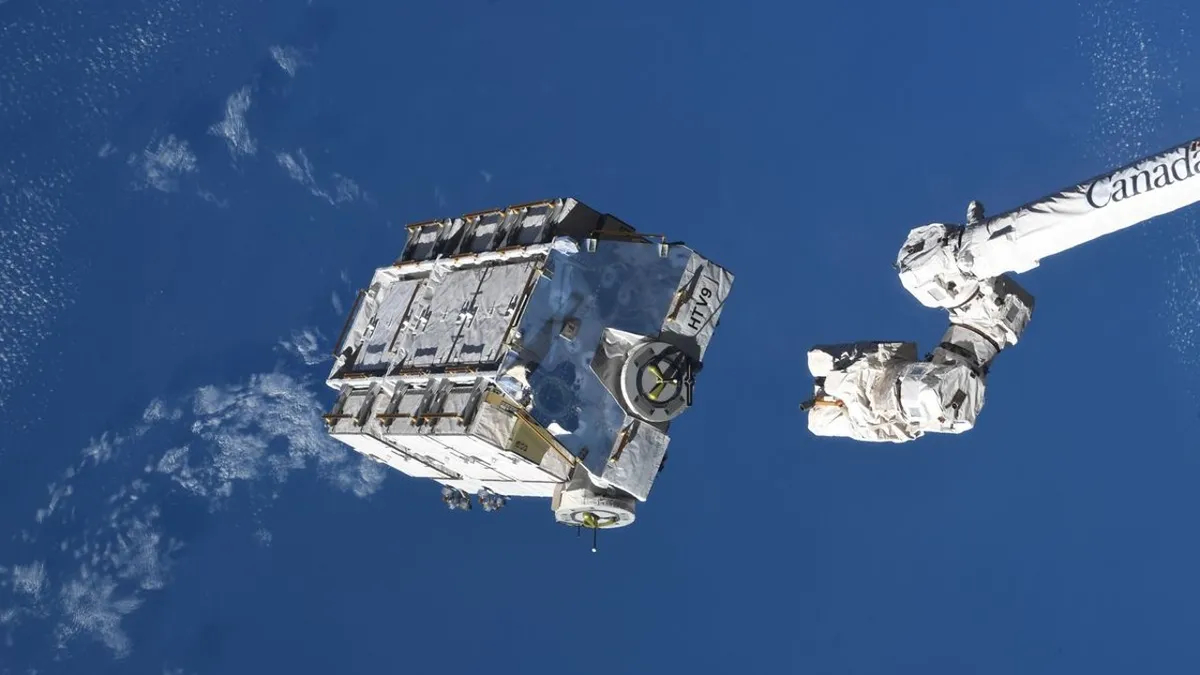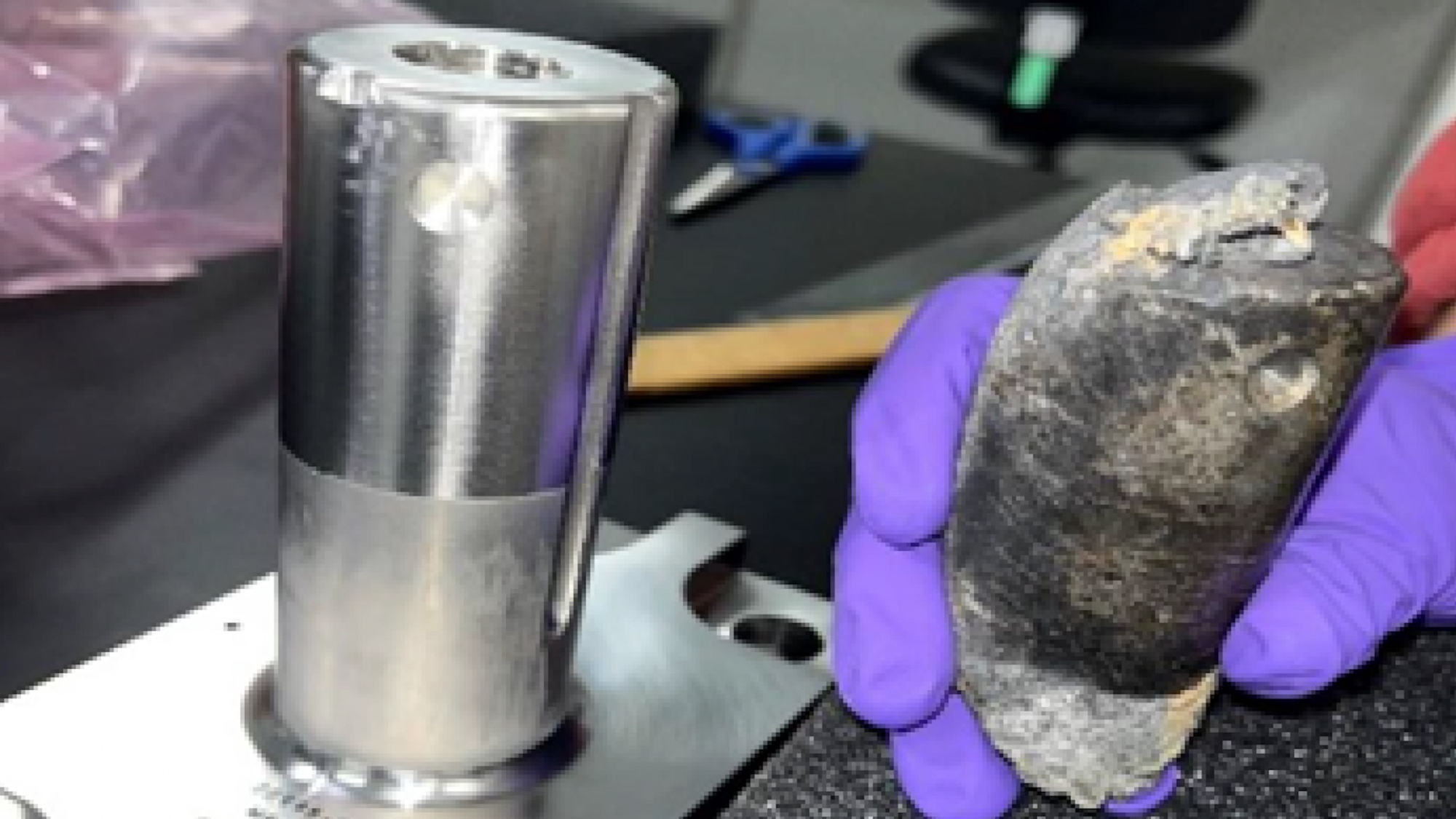
The mysterious object that crashed through the roof of a Florida home last month did indeed come from the International Space Station (ISS), NASA has confirmed.
That home, in the seaside city of Naples, belongs to Alejandro Otero. Shortly after the March 8 incident, Otero said he thought the offending object was part of a cargo pallet packed with 5,800 pounds (2,630 kilograms) of aging batteries jettisoned from the ISS in March 2021.
And he was right, according to a new NASA analysis of the object, which was performed at Florida's Kennedy Space Center.
"Based on the examination, the agency determined the debris to be a stanchion from the NASA flight support equipment used to mount the batteries on the cargo pallet," agency officials wrote in an update today (April 15).
The cylindrical piece of space junk is made of a metallic alloy called Inconel, they added. It weighs 1.6 pounds (0.7 kg) and measures 4 inches (10 centimeters) high by 1.6 inches (4 cm) wide.
Related: 5,800 pounds of batteries tossed off the ISS in 2021 will fall to Earth

The nickel-hydride batteries were dumped after new lithium-ion versions were delivered to the ISS for a power-supply upgrade. The pallet and the batteries were expected to burn up completely in Earth's atmosphere, NASA officials said in today's update — yet that didn't happen, and the agency wants to learn why.
Get the Space.com Newsletter
Breaking space news, the latest updates on rocket launches, skywatching events and more!
"The International Space Station will perform a detailed investigation of the jettison and reentry analysis to determine the cause of the debris survival and to update modeling and analysis, as needed," NASA officials wrote in today's update.
"NASA specialists use engineering models to estimate how objects heat up and break apart during atmospheric reentry," they added. "These models require detailed input parameters and are regularly updated when debris is found to have survived atmospheric reentry to the ground."
Otero's experience serves as a reminder that there's a tremendous amount of hardware whizzing over our heads.
According to the European Space Agency, Earth orbit hosts about 36,500 pieces of space junk at least 4 inches (10 cm) wide, and a whopping 130 million objects at least 1 millimeter in diameter. Even these tiny shards pose a danger to satellites and other orbiting assets, given the tremendous speeds at which they travel. For example, at 250 miles (400 kilometers) up — the average altitude of the ISS — orbital velocity is about 17,000 mph (27,400 kph).
And, as has been demonstrated, some of this junk comes crashing back to Earth from time to time. For instance, the 23-ton core stages of China's powerful Long March 5B rocket routinely fall in an uncontrolled fashion a week or so after their launches, to the consternation of the international space community.
NASA's new analysis may have financial consequences for the agency and for Otero, by the way.
"I eagerly await communication from the responsible agencies, as their assistance is crucial in resolving the damages from this deliberate release. But more importantly how in the future to arrange the payload so it will burn in its entirety as it reenters," Otero wrote via X on March 8, shortly after his home was hit.
Join our Space Forums to keep talking space on the latest missions, night sky and more! And if you have a news tip, correction or comment, let us know at: community@space.com.

Michael Wall is a Senior Space Writer with Space.com and joined the team in 2010. He primarily covers exoplanets, spaceflight and military space, but has been known to dabble in the space art beat. His book about the search for alien life, "Out There," was published on Nov. 13, 2018. Before becoming a science writer, Michael worked as a herpetologist and wildlife biologist. He has a Ph.D. in evolutionary biology from the University of Sydney, Australia, a bachelor's degree from the University of Arizona, and a graduate certificate in science writing from the University of California, Santa Cruz. To find out what his latest project is, you can follow Michael on Twitter.
-
Unclear Engineer DUH!Reply
"Inconel is a nickel-chromium-based superalloy often utilized in extreme environments where components are subjected to high temperature, pressure or mechanical loads. Inconel alloys are oxidation- and corrosion-resistant. When heated, Inconel forms a thick, stable, passivating oxide layer protecting the surface from further attack. Inconel retains strength over a wide temperature range, attractive for high-temperature applications where aluminium and steel would succumb to creep as a result of thermally-induced crystal vacancies."
It is also not cheap. Maybe find a way to return and recycle this type of material? -
sciencecompliance ReplyUnclear Engineer said:DUH!
Yeah, when they said it was made out of Inconel I shook my head. You mean the Inconel that's famous for its heat resistance? Jesus Christ, NASA. Get your shit together.
I hope they pay for the damages to this guy's house, but, ultimately, this could have been a lot worse. There needs to be a better protocol for jettisoning objects from orbit, so nobody gets hurt. -
Unclear Engineer Jettisoning a whole package of heavy stuff held together by strong Inconel pipes seems pretty negligent. It would make more sense to ensure that the package would break up quickly once it reaches the atmosphere. I can understand that they don't want a lot of separate pieces orbiting for a year or two, but they could have used some plastic zip ties to hold it together, rather than jut using the pre-existing Inconel frame.Reply
At some point, which probably should have been sooner than now, we need some proper protocols for jettisoning waste in orbit. With all sorts of other national and private space stations planned for the near future, this could become a hazard for both space vehicles and people on the ground.
it might be wise to force processes that will cost some money, such as providing de-orbiting engines and fuel for packages of space trash, so that their reentry points are clearly determined when released. -
sciencecompliance ReplyUnclear Engineer said:it might be wise to force processes that will cost some money, such as providing de-orbiting engines and fuel for packages of space trash, so that their reentry points are clearly determined when released.
Not that I'm not inclined to agree, but this is unfortunately more complicated than just strapping some solid rocket motors to the payload. You need a way to ensure that it can maintain a retrograde thrust vector for the duration of the deorbit burn, otherwise you could still have space debris, just in a different, possibly higher orbit. Maintaining a proper attitude during a burn is not a trivially simple task, especially if you have an irregularly shaped payload with a nonuniform density distribution. -
Unclear Engineer I agree that it is not as simple as putting a solid rocket on the trash and lighting it. It will need some sort of structure and a guidance system to make it work reliably. That is why it will cost some money - not just for the disposable garbage disposal systems, but for the process of launching that additional weight and volume into orbit to be used there.Reply
So, any policy to do that is likely to get some resistance from the people who would need to actually do it. -
newtons_laws There was little doubt that given the time and location of the debris that crashed through the Florida resident's home it was (as NASA has now confirmed) part of the jettisoned battery pallet.Reply
As a humorous aside, looking at the photo of the inconel stanchion that survived re-entry, why does there appear to be what looks like a frog on top of it? A good example of Pareidolia. :)









